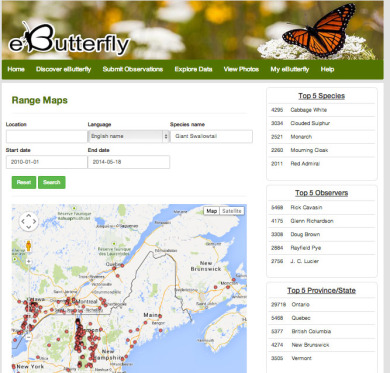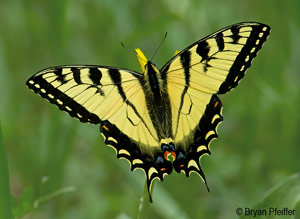Breaking News from VCE
NORWICH, Vermont – VCE and a team of biologists from the U.S. and Canada today launched an ambitious online project allowing scientists and the public to report, store, organize and view vast amounts of data on butterfly distribution across North America.
e-Butterfly.org offers its users – free of charge – lists, photos and real-time maps of butterflies from a database expected to amass millions of records gathered from thousands of observers. The site allows users to submit and organize their butterfly observations and photos, and to share them with others. Regional experts also help e-Butterfly.org users with butterfly identification.
“We believe e-Butterfly is the best thing to happen to butterflies and lepidopterists since flowers and nectar,” said Kent McFarland, a conservation biologist at the Vermont Center for Ecostudies and a partner in development of the site. “Virtually anyone can contribute sightings and photos, store them on our servers and mine our growing data for anything from research to recreation.”
In many respects, butterflies have followed birds into the digital age. Known for keeping meticulous lists and notes, birdwatchers have for decades provided population and distribution data to ornithologists and conservationists, most of it now gathered online at eBird.org.
Butterflies are next in line and online, supported by a growing interest in recreational butterfly watching. e-Butterfly also allows users to organize and present their own sightings by state, province or country in a fashion similar to eBird.
e-Butterfly.org also serves science, conservation and education. Butterflies can act as early warning signals for habitat degradation, changes in climate and other ecological forces. By collecting observations into its growing, open-access database, e-Butterfly will become a powerful resource for naturalists, educators, lepidopterists, conservationists, land managers, and policy makers.
“The new e-Butterfly is the perfect long-term monitoring tool for thousands of individuals to  contribute data on butterfly observations from all over North America for decades to come,” said Kathleen Prudic, a research scientist at Oregon State University and collaborator on the project. “This will be an essential and wonderful opportunity for people to get involved in science, appreciate nature, and interact with and enjoy biodiversity.”
contribute data on butterfly observations from all over North America for decades to come,” said Kathleen Prudic, a research scientist at Oregon State University and collaborator on the project. “This will be an essential and wonderful opportunity for people to get involved in science, appreciate nature, and interact with and enjoy biodiversity.”
e-Butterfly.org took root in Canada with Dr. Jeremy Kerr’s innovative eco-informatics butterfly research at the University of Ottawa, where Maxim Larrivée, now an entomologist at the Montreal Insectarium, sought to unify all of Canada’s butterfly records into a single database. Among his goals was to track butterfly distribution and understand the impacts of global change on Canadian butterflies. Although the Canadian site was a success, Larrivée soon recognized the benefits of expanding it across North America, since butterflies are unbounded by borders.
The new e-Butterfly employs more powerful computers and a more effective user interface for storing, retrieving and sharing data on the site in a form of butterfly social media.
“e-Butterfly is the tool for any lepidopterist,” said Larrivée, “from beginners looking for help with butterfly identification to experts who may want to plan their outings based on what species are active on any date at any particular location.”


Pingbacks (1)
[…] Butterflies Meet Big Data and Social Media […]